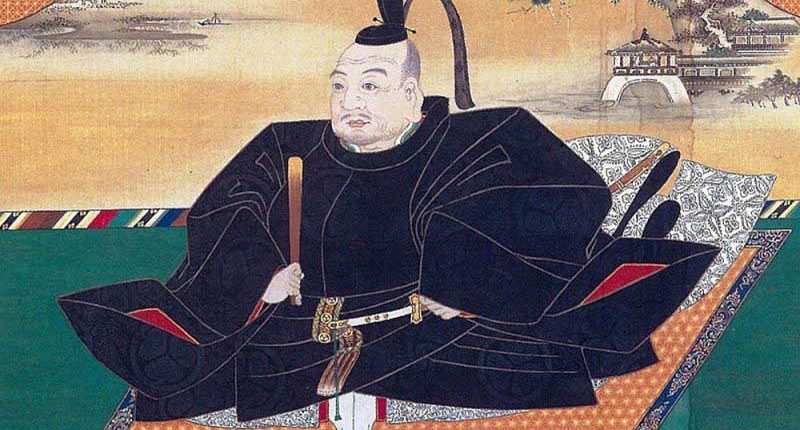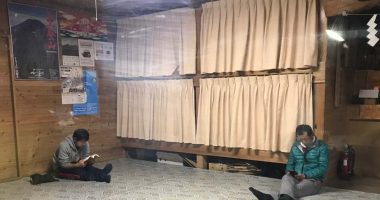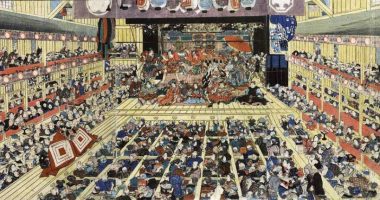The ebb and flow of power between various factions dictated domestic history for much of the following centuries. In the same way that an emperor relying on the loyalty of increasingly powerful and militarized families was a recipe for civil disharmony, the fact that the shogun’s power rested at least partially in the allegiance of numerous daimyo (feudal lords) precipitated a similar dissipation of control.
Foreign forces, specifically the attempted invasions by Mongol forces in 1274 and 1281, also played a notable role in diluting the power of the shoguns: whereas the victors in inter-clan warfare could distribute lands and spoils as rewards to their loyal samurai, invading forces offered no land and very few spoils, leading to malcontent and weakening the samurai’s bond with the shogun.
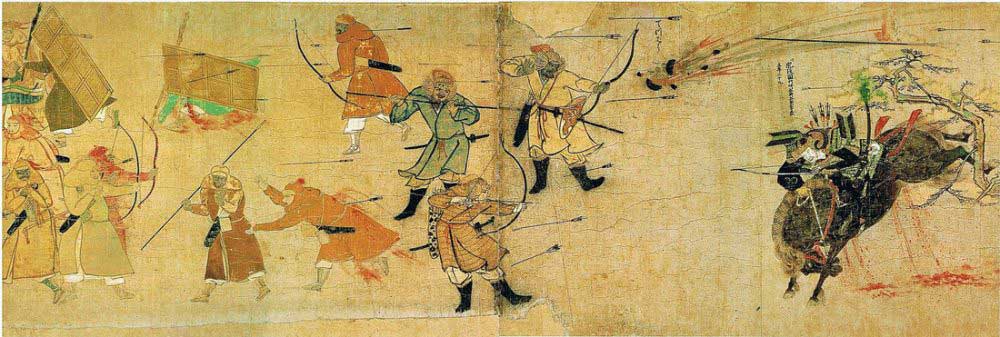
By the end of the 15th century the country had descended into a period of civil war known as the sengoku-jidai. For the next 100 years the powerful clans spread throughout the land would each vie to further their position in the political landscape. These clans had their own “house codes”, which often took precedence over the laws of the government, and in some cases even issued their own currency. This is not to say that the emperor and shogun ceased to exist; merely, that their control over the domains of the daimyo was limited at best. The daimyo did, however, continue to pay lip service to their former masters, albeit more out of political maneuvering and the fear of being outflanked in the constant power struggle than any real sense of allegiance.
The sengoku-jidai also left its mark on the physical landscape: agriculture progressed as the daimyo tried to make the most of the land in their domain, and castles began to mottle the landscape as they sought to shore up their defences or make conspicuous displays of power. Indeed, many of Japan’s most famous castles were constructed during these centuries of civil strife (Himeiji, 1333; Odawara Castle, 1447; Matsumoto Castle, 1504). Three men would eventually reunify Japan: Oda Nobunaga, Toyotomi Hideyoshi, and Tokugawa Ieyasu.
Oda Nobunaga was by far the most brutal of the three, a trait that was probably a prerequisite for someone seeking to reunify a country in civil war through violence. Born in Nagoya to a deputy military governor, he took control of the family land upon his father’s death in 1551. Within six years he had slaughtered his uncle and younger brother—both of whom had made attempts to seize power from him—and had begun a ruthless campaign to extend his territory. Little mercy was shown to those who displeased or disobeyed him, and the militarized Buddhists sects in particular received short shrift, Nobunaga making it a seemingly personal goal to exterminate them at the root.
Ironically, while foreign influences had been a catalyst for the weakening of the shogun’s power and eruption of civil war, they also provided the thing that would help put the pieces back together: the gun. Acutely aware of the role this new technology could play in the battlefield, even before his father’s death Nobunaga had ordered 500 tanegashima (Japanese arquebuses) from Japanese makers and ensured that they were a permanent fixture in his swelling army.
Watching power grow in the hands of Nobunaga, the shogun attempted to placate him with positions of “vice-shogun”. After this failed he decided to take a stand with other daimyo, a development which resulted in Nobunaga surrounding and then burning the capital, Kyoto, in 1573, and forcing the shogun to flee into exile after uncharacteristically sparing his life. By the time of Nobunaga’s own violent death nine years later (he committed seppuku (ritual suicide) after being betrayed and put under siege by one of his own vassals), he had made territorial gains that were to form the base for further unification by his successors, Toyotomi Hideyoshi and Tokugawa Ieyasu.
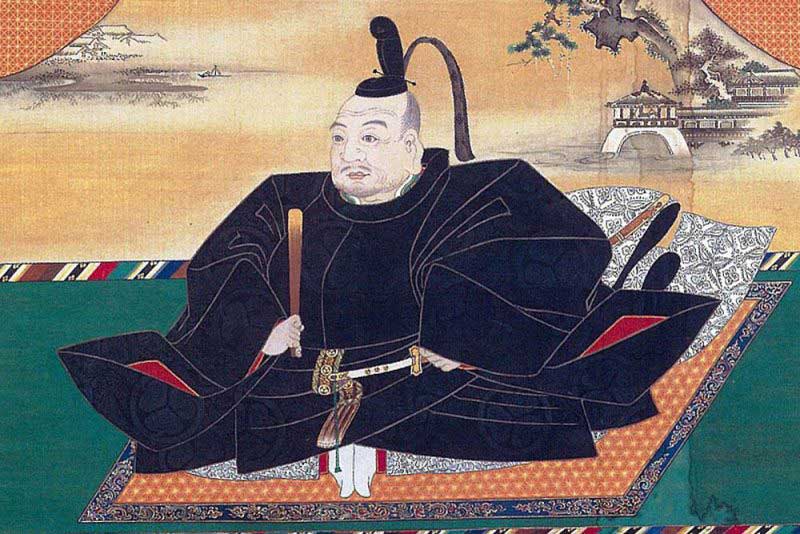
Both Toyotomi Hideyoshi and Tokugawa Ieyasu were very much raised in the shadow of Nobunaga. Hideyoshi was born in 1537 to one of Nobunaga’s foot soldiers. A brilliant strategist, Hideyoshi worked his way up to be one of Nobunaga’s most trusted aides. Ieyasu was six years Hideyoshi’s junior, born in 1543 to a minor lord of Mikawa (part of Aichi Prefecture today).
Ieyasu’s early years tell a good tale of the tumultuous times towards the end of the sengoku-jidai. At the age of six Ieyasu was sent off by his father as a “hostage” to the Imagawa clan in exchange for their support in defending against attacks from the Oda clan (the same Oda clan that would, under the leadership of Oda Nobunaga, shortly come to dominate the region). Learning of this arrangement, Oda Nobuhide, father of the unifier Nobunaga, had Ieyasu captured while on route. Nobuhide then proceeded to threaten Ieyasu’s father with his son’s execution unless he immediately cut ties with the Imagawa clan (Ieyasu’s father refused, instead replying that his son’s execution would only act as testimony to the strength of these ties). Despite this obvious act of defiance, Ieyasu’s life was somehow spared and he remained a captive of the Oda clan.
Upon the death of Nobuhide in 1551, the Oda clan’s hold on power temporarily faltered and the Imagawa clan took the opportunity to surround their enemy’s stronghold. It was Oda Nobunaga who brokered the deal which saw an end to the siege in exchange for the release of Ieyasu. And so, at the age of nine, having been passed from one captor to another, Ieyasu continued on his original passage to the Imagawa clan’s domain. He grew up to be a great warrior and made a name for himself fighting the Oda clan on behalf of the Imagawa clan. But his allegiances did not run deep and he decided to switch sides when the Imagawa clan’s leader was killed in an attack by Nobunaga.
Upon Nobunaga’s death in 1582 Hideyoshi emerged as the successor and Ieyasu served under him. Hideyoshi was more merciful than his predecessor, favoring a more subtle approach to pacifying rivals such as adopting their sons and allowing defeated enemies to join his forces. He nevertheless had his mind set on territorial expansion: he conquered Shikoku in 1585 and Kyushu in 1587 before turning his attention abroad to Korea, sending 160,000 troops in 1592 and another 140,000 in 1597. These ultimately unsuccessful foreign excursions would bog Hideyoshi down and, more lastingly, sow seeds of resentment in Korea which suffered devastation during the war.
Aside from his role in unifying Japan, Hideyoshi is remembered for his katana-gari (“Sword Hunt”), an edict which forced the samurai to live in the cities with their daimyo and forbade farmers from bearing arms. This took away the samurai’s independent power bases and ensured that no-one could do what he had—take territory by force.
Ieyasu’s allegiance to Hideyoshi was not a strong one: within two years of Hideyoshi taking power Ieyasu had decided to support the claim of one of Nobunaga’s sons, Oda Nobukatsu, to be the rightful successor to Nobunaga, and a series of battles ensued which ended in peace negotiations. Hideyoshi and Ieyasu did, however, join forces in 1590 at the Siege of Odawara to annex the provinces held by the Hojo clan—the Kanto area which included Edo (now Tokyo)—but afterwards a deal was struck between the two men that saw Ieyasu give up his five southern provinces in exchange for the then-undeveloped Kanto area. This would prove critical in Ieyasu’s rise to power.
It was at this point, with the north blocked by Ieyasu, that Hideyoshi turned his attention to Korea, an endeavor that put a strain on his resources and left Ieyasu free to concentrate on the administration and development of the rich Kanto plains—a task at which he proved particularly adept. Upon Hideyoshi’s death in 1598, this power base ultimately gave Ieyasu the foundations from which to take victory at the Battle of Sekigahara in 1600 and assume the title of shogun, heralding in an era known as the Edo period. The Tokugawa shogunate would rule Japan for over 250 years.
- Next: The Edo Period
- Previous: The Emergence of Japan
